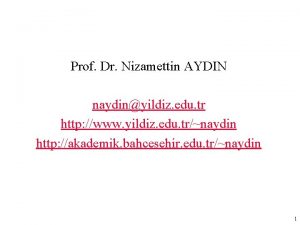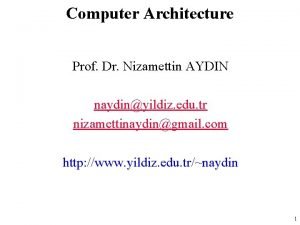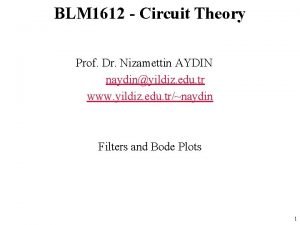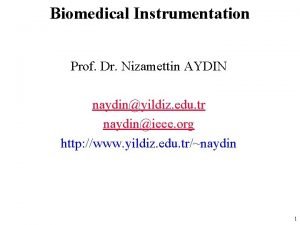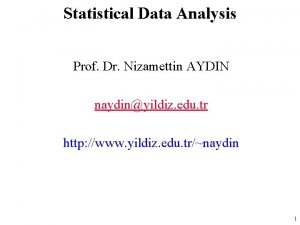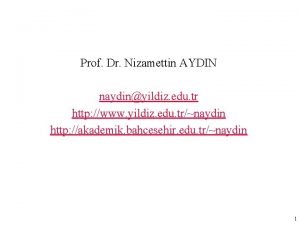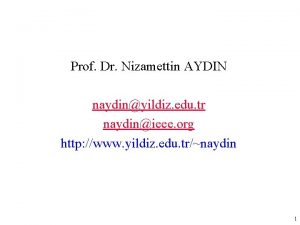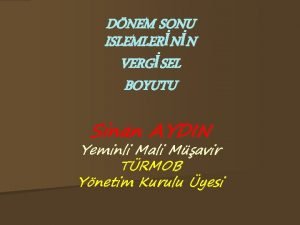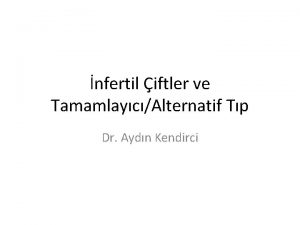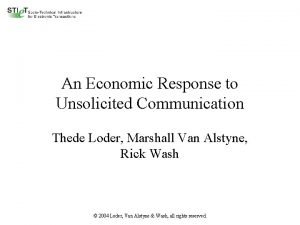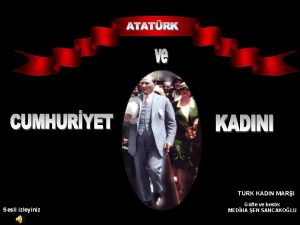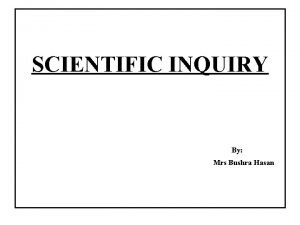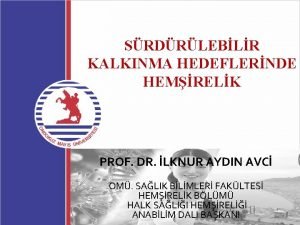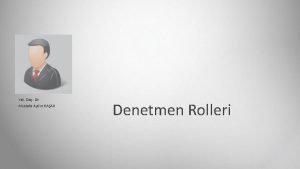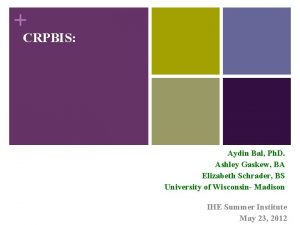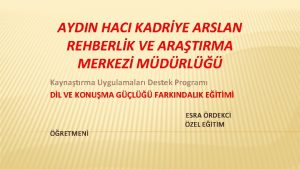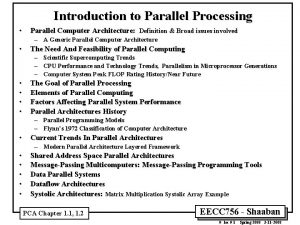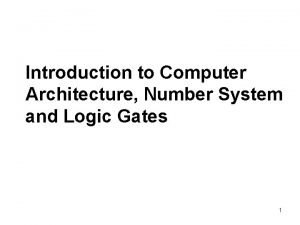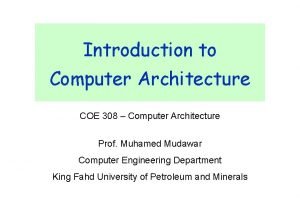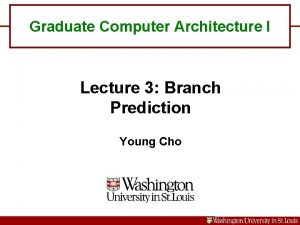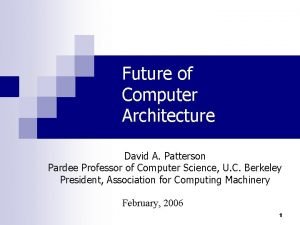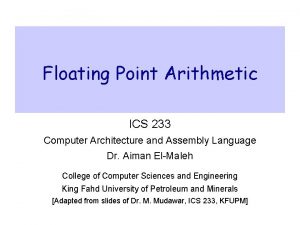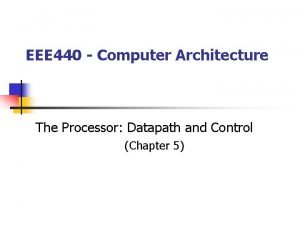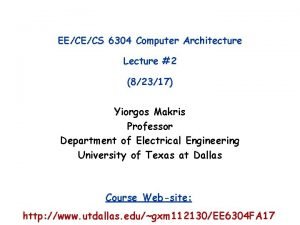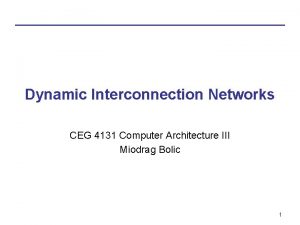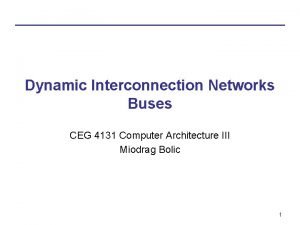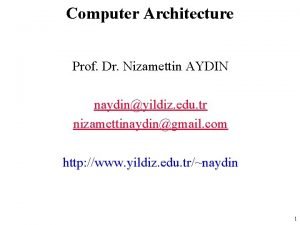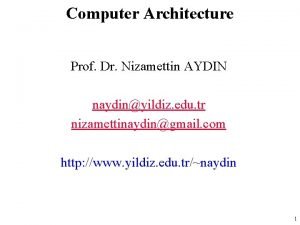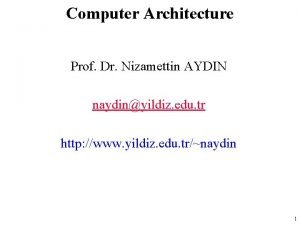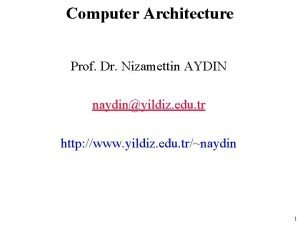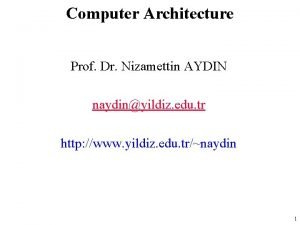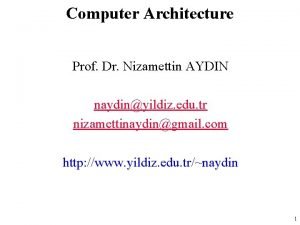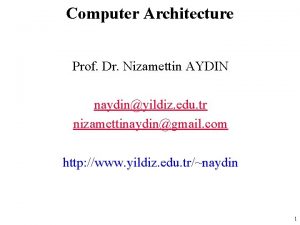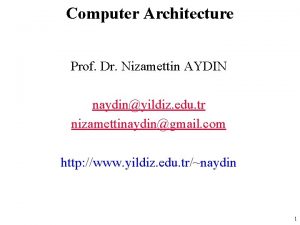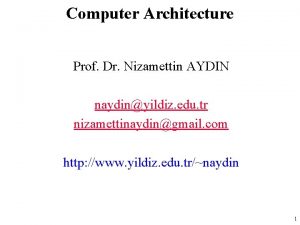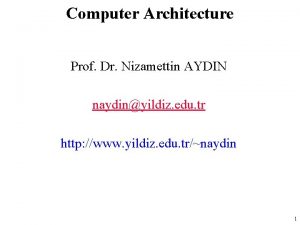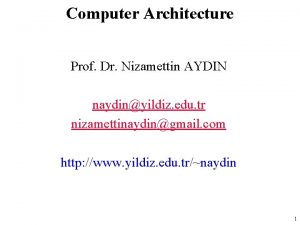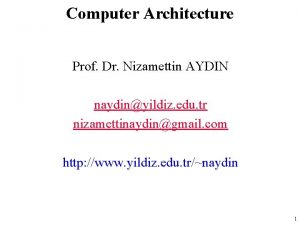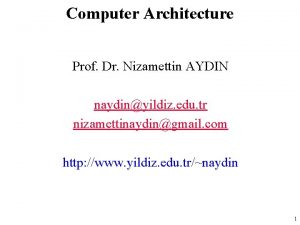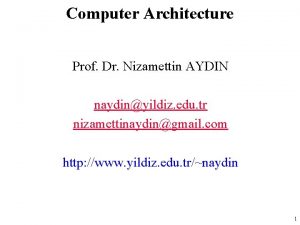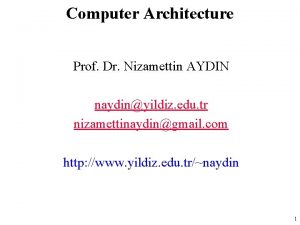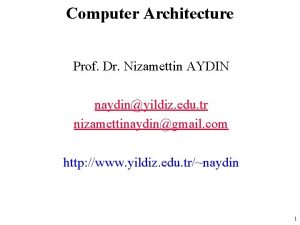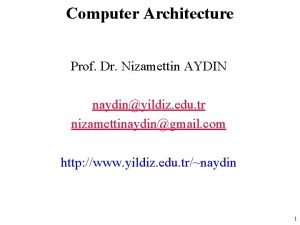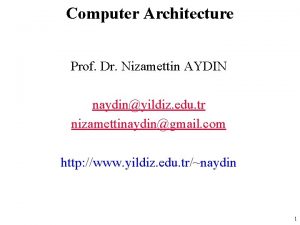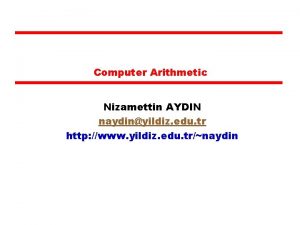Computer Architecture Prof Dr Nizamettin AYDIN naydinyildiz edu






























































- Slides: 62

Computer Architecture Prof. Dr. Nizamettin AYDIN naydin@yildiz. edu. tr nizamettinaydin@gmail. com http: //www. yildiz. edu. tr/~naydin 1

Computer Architecture Operating System Support 2

Outline • Objectives and Functions of OS • Operating System Services • Types of Operating System – – Interactive Batch Single program Multi-programming • Scheduling – Long Term Scheduling – Medium Term Scheduling – Short Term Scheduler • • • Swapping Partitioning Relocation Paging Virtual Memory Segmentation 3

Operating System • A computer consists of modules of three basic types that communicate with each other. – CPU – Memory – Input/Output • Management of these modules is done by OS. 4

Objectives and Functions of OS • Convenience – An operating system makes a computer easier to use • Efficiency – An operating system allows better use of computer resources 5

Layers and Views of a Computer System 6

Operating System Services • • Program creation Program execution Access to I/O devices Controlled access to files System access Error detection and response Accounting 7

O/S as a Resource Manager • A computer is a set of resources for the movement, storage, and processing of data and for the control of these functions • The O/S is responsible for managing these resources • O/S is a program executed by the processor • The O/S frequently relinquishes control and must depend on the processor to allow it to regain control 8

Main Resources managed by the O/S 9

Types of Operating System • Interactive – User/programmer interacts directly with the computer through a keyboard/display terminal • Batch – Opposite of interactive. Rare • Single program (Uni-programming) – Works only one program at atime • Multi-programming (Multi-tasking) – Processor works on more than one program at a time 10

Early Systems • Late 1940 s to mid 1950 s – No Operating System – Programs interact directly with hardware • Two main problems: – Scheduling: – Setup time 11

Simple Batch Systems • • Resident Monitor program Users submit jobs to operator Operator batches jobs Monitor controls sequence of events to process batch • When one job is finished, control returns to Monitor which reads next job • Monitor handles scheduling 12

Memory Layout for Resident Monitor 13

Job Control Language • Instructions to Monitor • Usually denoted by $ • e. g. – $JOB – $FTN –. . . Some Fortran instructions – $LOAD – $RUN –. . . Some data – $END 14

Desirable Hardware Features • Memory protection – To protect the Monitor • Timer – To prevent a job monopolizing the system • Privileged instructions – Only executed by Monitor – e. g. I/O • Interrupts – Allows for relinquishing and regaining control 15

Multi-programmed Batch Systems • I/O devices very slow • When one program is waiting for I/O, another can use the CPU • Following illustrates the problem: – the calculation concerns a program that processes a file of records and performs, on average, 100 processor instructions per record. • In this example the computer spends over 96% of its time waiting for I/O devices to finish transferring data. System utilization example 16

Single vs Multi-Programming • Single program • Multi-Programming with two programs 17

Single vs Multi-Programming • Multi-Programming with Three Programs 18

Example- benefits of mutiprogramming • Consider a computer with 250 MBytes of memory, a disk, a terminal, and a printer. • The programs JOB 1, JOB 2, and JOB 3 are submitted for execution at the same time with the following attributes: • We assume minimal processor requirements for JOB 2 and JOB 3 and continuous disk and printer use by JOB 3. • For a simple batch environment, these jobs will be executed in sequence 19

Utilization histograms 20

Effects of Multiprogramming on Resource Utilization 21

Time Sharing Systems • Allow users to interact directly with the computer – i. e. Interactive • Multi-programming allows a number of users to interact with the computer 22

Scheduling • Scheduling is key to multi-programming • A process is: – A program in execution – The “animated spirit” of a program – That entity to which a processor is assigned • Types of scheduling: 23

Long Term Scheduling • Determines which programs are submitted for processing • i. e. controls the degree of multi-programming • Once submitted, a job becomes a process for the short term scheduler • (or it becomes a swapped out job for the medium term scheduler) 24

Medium Term Scheduling • Part of the swapping function (later…) • Usually based on the need to manage multiprogramming • If no virtual memory, memory management is also an issue 25

Short Term Scheduler • Also known as Dispatcher, executes frequently and makes the fine grained decisions of which job to execute next – i. e. which job actually gets to use the processor in the next time slot • 5 define states in a process state: – New: • A program is admitted by the high-level schedular but is not yet ready to execute – Ready: • The process is ready to execute – Running: • The prcess is being executed – Waiting: • The process is suspended, waiting for some system resources – Halted: • The process has terminated and will be destroyed by the O/S. 26

Five State Process Model 27

Process Control Block 28

Scheduling Example 29

Key Elements of O/S for Multiprogramming 30

Queuing Diagram Representation of Process Scheduling 31

Memory Management • Task of dynamically subdivison of memory • Effective memory management is vital in a multiprogramming system • Uni-program – Memory split into two – One for Operating System (monitor) – One for currently executing program • Multi-program – “User” part is sub-divided and shared among active processes 32

Swapping • Problem: – I/O is so slow compared with CPU that even in multi-programming system, CPU can be idle most of the time • Solutions: – Increase main memory • Expensive • Leads to larger programs – Swapping 33

What is Swapping? • Long term queue of processes stored on disk • Processes “swapped” in as space becomes available • As a process completes it is moved out of main memory • If none of the processes in memory are ready (i. e. all I/O blocked) – Swap out a blocked process to intermediate queue – Swap in a ready process or a new process – But swapping is an I/O process… 34

Use of Swapping 35

Partitioning • Splitting memory into sections to allocate to processes (including Operating System) • Fixed-sized partitions – May not be equal size – Process is fitted into smallest hole that will take it (best fit) – Some wasted memory – Leads to variable sized partitions 36

Fixed Partitioning 37

Variable Sized Partitions (1) • Allocate exactly the required memory to a process • This leads to a hole at the end of memory, too small to use – Only one small hole - less waste • When all processes are blocked, swap out a process and bring in another • New process may be smaller than swapped out process • Another hole 38

Variable Sized Partitions (2) • Eventually have lots of holes – (fragmentation) • Solutions: – Coalesce • Join adjacent holes into one large hole – Compaction • From time to time go through memory and move all hole into one free block (c. f. disk de-fragmentation) 39

Effect of Dynamic Partitioning 40

Relocation • No guarantee that process will load into the same place in memory • Instructions contain addresses – Locations of data • Addresses for instructions (branching) • Logical address – relative to beginning of program • Physical address – actual location in memory (this time) • Automatic conversion using base address 41

Paging • Split memory into equal sized, small chunks page frames • Split programs (processes) into equal sized small chunks - pages • Allocate the required number page frames to a process • Operating System maintains list of free frames • A process does not require contiguous page frames • Use page table to keep track 42

Allocation of Free Frames 43

Logical and Physical Addresses - Paging 44

Virtual Memory • Demand paging – Do not require all pages of a process in memory – Bring in pages as required • Page fault – Required page is not in memory – Operating System must swap in required page – May need to swap out a page to make space – Select page to throw out based on recent history 45

Thrashing • • Too many processes in too little memory Operating System spends all its time swapping Little or no real work is done Disk light is on all the time • Solutions – Good page replacement algorithms – Reduce number of processes running – Fit more memory 46

Bonus • We do not need all of a process in memory for it to run • We can swap in pages as required • So - we can now run processes that are bigger than total memory available! • Main memory is called real memory • User/programmer sees much bigger memory virtual memory 47

Inverted Page Table Structure 48

Translation Lookaside Buffer • Every virtual memory reference causes two physical memory access – Fetch page table entry – Fetch data • Use special cache for page table – TLB 49

TLB Operation 50

TLB and Cache Operation 51

Segmentation • Paging is not (usually) visible to the programmer • Segmentation is visible to the programmer • Usually different segments allocated to program and data • May be a number of program and data segments 52

Advantages of Segmentation • Simplifies handling of growing data structures • Allows programs to be altered and recompiled independently, without re-linking and reloading • Lends itself to sharing among processes • Lends itself to protection • Some systems combine segmentation with paging 53

Pentium II • Hardware for segmentation and paging • Unsegmented unpaged – virtual address = physical address – Low complexity – High performance • Unsegmented paged – Memory viewed as paged linear address space – Protection and management via paging – Berkeley UNIX • Segmented unpaged – Collection of local address spaces – Protection to single byte level – Translation table needed is on chip when segment is in memory • Segmented paged – Segmentation used to define logical memory partitions subject to access control – Paging manages allocation of memory within partitions – Unix System V 54

Pentium II Address Translation Mechanism 55

Pentium II Segmentation • Each virtual address is 16 -bit segment and 32 bit offset • 2 bits of segment are protection mechanism • 14 bits specify segment • Unsegmented virtual memory 232 = 4 Gbytes • Segmented 246 = 64 terabytes – Can be larger – depends on which process is active – Half (8 K segments of 4 Gbytes) is global – Half is local and distinct for each process 56

Pentium II Protection • Protection bits give 4 levels of privilege – 0 most protected, 3 least – Use of levels software dependent – Usually level 3 for applications, level 1 for O/S and level 0 for kernel (level 2 not used) – Level 2 may be used for apps that have internal security e. g. database – Some instructions only work in level 0 57

Pentium II Paging • Segmentation may be disabled – In which case linear address space is used • Two level page table lookup – First, page directory • 1024 entries max • Splits 4 G linear memory into 1024 page groups of 4 Mbyte • Each page table has 1024 entries corresponding to 4 Kbyte pages • Can use one page directory for all processes, one per process or mixture • Page directory for current process always in memory – Use TLB holding 32 page table entries – Two page sizes available 4 k or 4 M 58

Power. PC Memory Management Hardware • 32 bit – paging with simple segmentation – 64 bit paging with more powerful segmentation • Or, both do block address translation – Map 4 large blocks of instructions & 4 of memory to bypass paging – e. g. OS tables or graphics frame buffers • 32 bit effective address – 12 bit byte selector • =4 kbyte pages – 16 bit page id • 64 k pages per segment – 4 bits indicate one of 16 segment registers • Segment registers under OS control 59

Power. PC 32 -bit Memory Management Formats 60

Power. PC 32 -bit Address Translation 61

62
 Prof. dr. nizamettin aydin
Prof. dr. nizamettin aydin Prof. dr. nizamettin aydin
Prof. dr. nizamettin aydin Prof. dr. nizamettin aydin
Prof. dr. nizamettin aydin Prof. dr. nizamettin aydin
Prof. dr. nizamettin aydin Nizamettin aydin
Nizamettin aydin Package diagram
Package diagram Kilo mega giga tera
Kilo mega giga tera Sinan aydın mali müşavir
Sinan aydın mali müşavir Aydın kendirci
Aydın kendirci Thede loder
Thede loder Sevil aydın
Sevil aydın Aydın bir türk kadınıyım
Aydın bir türk kadınıyım Bushra hasan
Bushra hasan Organization
Organization Aydin marine
Aydin marine Aydın başar
Aydın başar Nazmi aydın
Nazmi aydın Aydin bal
Aydin bal Aydın kekemelik merkezi
Aydın kekemelik merkezi 3 bus architecture
3 bus architecture Diff between computer organization and architecture
Diff between computer organization and architecture Register in computer organization
Register in computer organization Edu.sharif.edu
Edu.sharif.edu What is architecture business cycle
What is architecture business cycle Call and return architecture in software engineering
Call and return architecture in software engineering Fundamental and incidental interactions
Fundamental and incidental interactions Slot modular architecture
Slot modular architecture Computer organization and architecture 10th solution
Computer organization and architecture 10th solution Fast desktop for architecture software
Fast desktop for architecture software Iit kharagpur virtual lab
Iit kharagpur virtual lab Introduction to computer organization and architecture
Introduction to computer organization and architecture Timing and control in computer architecture
Timing and control in computer architecture Evolution and interpretation of computer architecture
Evolution and interpretation of computer architecture Dma controller in computer architecture
Dma controller in computer architecture Floating point division algorithm in computer architecture
Floating point division algorithm in computer architecture Addressing mode in computer architecture
Addressing mode in computer architecture Chordal ring
Chordal ring Smt computer architecture
Smt computer architecture Pseudo instructions are
Pseudo instructions are 111011-100100
111011-100100 Instruction format in computer architecture
Instruction format in computer architecture Explain the concept of nano programming
Explain the concept of nano programming A microprogram sequencer ______________________.
A microprogram sequencer ______________________. Memory system
Memory system Dram memory mapping
Dram memory mapping Linear pipelining in computer architecture
Linear pipelining in computer architecture Computer architecture definition
Computer architecture definition Parallel processing architecture
Parallel processing architecture Architect of number system
Architect of number system Computer architecture definition
Computer architecture definition Instruction set
Instruction set Output devices of computer
Output devices of computer Branch prediction
Branch prediction Computer architecture david patterson
Computer architecture david patterson Multiple instruction single data
Multiple instruction single data What is guard bit in computer architecture
What is guard bit in computer architecture Parallel priority interrupt
Parallel priority interrupt Basic mips implementation in computer architecture
Basic mips implementation in computer architecture Explain virtual memory in computer architecture
Explain virtual memory in computer architecture Computer architecture definition
Computer architecture definition Baseline network in computer architecture
Baseline network in computer architecture Bus interconnection in computer architecture
Bus interconnection in computer architecture Harris & harris digital design and computer architecture
Harris & harris digital design and computer architecture
